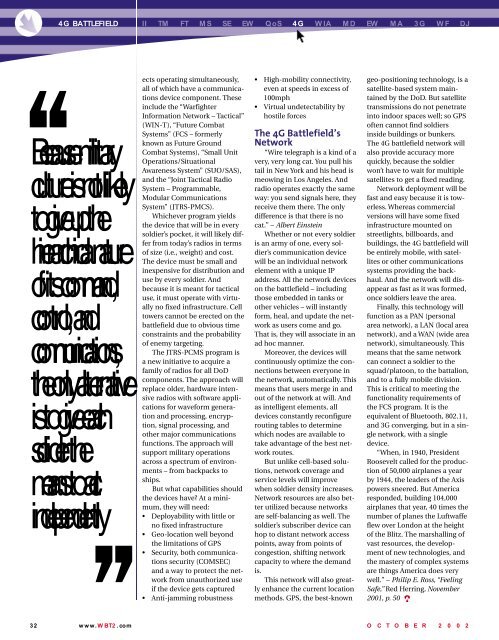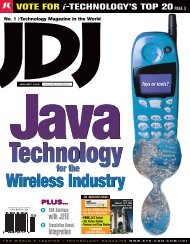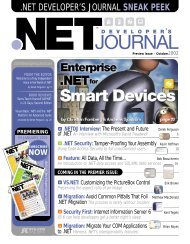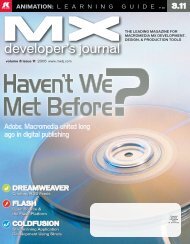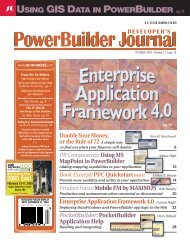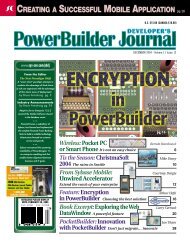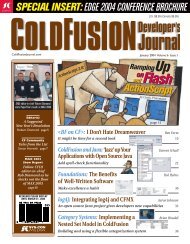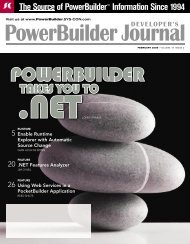wireless in action - sys-con.com's archive of magazines - SYS-CON ...
wireless in action - sys-con.com's archive of magazines - SYS-CON ...
wireless in action - sys-con.com's archive of magazines - SYS-CON ...
- No tags were found...
Create successful ePaper yourself
Turn your PDF publications into a flip-book with our unique Google optimized e-Paper software.
4G BATTLEFIELDII TM FT MS SE EW QoS 4G WIA MD EW MA 3G WF DJBecause militaryculture is not likelyto give up thehierarchical nature<strong>of</strong> its command,<strong>con</strong>trol, andcommunications,the only alternativeis to give eachsolider themeans to act<strong>in</strong>dependentlyects operat<strong>in</strong>g simultaneously,all <strong>of</strong> which have a communicationsdevice component. These<strong>in</strong>clude the “WarfighterInformation Network – Tactical”(WIN-T), “Future CombatSystems” (FCS – formerlyknown as Future GroundCombat Systems), “Small UnitOperations/SituationalAwareness System” (SUO/SAS),and the “Jo<strong>in</strong>t Tactical RadioSystem – Programmable,Modular CommunicationsSystem” (JTRS-PMCS).Whichever program yieldsthe device that will be <strong>in</strong> everysoldier’s pocket, it will likely differfrom today’s radios <strong>in</strong> terms<strong>of</strong> size (i.e., weight) and cost.The device must be small and<strong>in</strong>expensive for distribution anduse by every soldier. Andbecause it is meant for tacticaluse, it must operate with virtuallyno fixed <strong>in</strong>frastructure. Celltowers cannot be erected on thebattlefield due to obvious time<strong>con</strong>stra<strong>in</strong>ts and the probability<strong>of</strong> enemy target<strong>in</strong>g.The JTRS-PCMS program isa new <strong>in</strong>itiative to acquire afamily <strong>of</strong> radios for all DoDcomponents. The approach willreplace older, hardware <strong>in</strong>tensiveradios with s<strong>of</strong>tware applicationsfor waveform generationand process<strong>in</strong>g, encryption,signal process<strong>in</strong>g, andother major communicationsfunctions. The approach willsupport military operationsacross a spectrum <strong>of</strong> environments– from backpacks toships.But what capabilities shouldthe devices have? At a m<strong>in</strong>imum,they will need:• Deployability with little orno fixed <strong>in</strong>frastructure• Geo-location well beyondthe limitations <strong>of</strong> GPS• Security, both communicationssecurity (COMSEC)and a way to protect the networkfrom unauthorized useif the device gets captured• Anti-jamm<strong>in</strong>g robustness• High-mobility <strong>con</strong>nectivity,even at speeds <strong>in</strong> excess <strong>of</strong>100mph• Virtual undetectability byhostile forcesThe 4G Battlefield’sNetwork“Wire telegraph is a k<strong>in</strong>d <strong>of</strong> avery, very long cat. You pull histail <strong>in</strong> New York and his head ismeow<strong>in</strong>g <strong>in</strong> Los Angeles. Andradio operates exactly the sameway: you send signals here, theyreceive them there. The onlydifference is that there is nocat.” – Albert E<strong>in</strong>ste<strong>in</strong>Whether or not every soldieris an army <strong>of</strong> one, every soldier’scommunication devicewill be an <strong>in</strong>dividual networkelement with a unique IPaddress. All the network deviceson the battlefield – <strong>in</strong>clud<strong>in</strong>gthose embedded <strong>in</strong> tanks orother vehicles – will <strong>in</strong>stantlyform, heal, and update the networkas users come and go.That is, they will associate <strong>in</strong> anad hoc manner.Moreover, the devices will<strong>con</strong>t<strong>in</strong>uously optimize the <strong>con</strong>nectionsbetween everyone <strong>in</strong>the network, automatically. Thismeans that users merge <strong>in</strong> andout <strong>of</strong> the network at will. Andas <strong>in</strong>telligent elements, alldevices <strong>con</strong>stantly re<strong>con</strong>figurerout<strong>in</strong>g tables to determ<strong>in</strong>ewhich nodes are available totake advantage <strong>of</strong> the best networkroutes.But unlike cell-based solutions,network coverage andservice levels will improvewhen soldier density <strong>in</strong>creases.Network resources are also betterutilized because networksare self-balanc<strong>in</strong>g as well. Thesoldier’s subscriber device canhop to distant network accesspo<strong>in</strong>ts, away from po<strong>in</strong>ts <strong>of</strong><strong>con</strong>gestion, shift<strong>in</strong>g networkcapacity to where the demandis.This network will also greatlyenhance the current locationmethods. GPS, the best-knowngeo-position<strong>in</strong>g technology, is asatellite-based <strong>sys</strong>tem ma<strong>in</strong>ta<strong>in</strong>edby the DoD. But satellitetransmissions do not penetrate<strong>in</strong>to <strong>in</strong>door spaces well; so GPS<strong>of</strong>ten cannot f<strong>in</strong>d soldiers<strong>in</strong>side build<strong>in</strong>gs or bunkers.The 4G battlefield network willalso provide accuracy morequickly, because the soldierwon’t have to wait for multiplesatellites to get a fixed read<strong>in</strong>g.Network deployment will befast and easy because it is towerless.Whereas commercialversions will have some fixed<strong>in</strong>frastructure mounted onstreetlights, billboards, andbuild<strong>in</strong>gs, the 4G battlefield willbe entirely mobile, with satellitesor other communications<strong>sys</strong>tems provid<strong>in</strong>g the backhaul.And the network will disappearas fast as it was formed,once soldiers leave the area.F<strong>in</strong>ally, this technology willfunction as a PAN (personalarea network), a LAN (local areanetwork), and a WAN (wide areanetwork), simultaneously. Thismeans that the same networkcan <strong>con</strong>nect a soldier to thesquad/platoon, to the battalion,and to a fully mobile division.This is critical to meet<strong>in</strong>g thefunctionality requirements <strong>of</strong>the FCS program. It is theequivalent <strong>of</strong> Bluetooth, 802.11,and 3G <strong>con</strong>verg<strong>in</strong>g, but <strong>in</strong> a s<strong>in</strong>glenetwork, with a s<strong>in</strong>gledevice.“When, <strong>in</strong> 1940, PresidentRoosevelt called for the production<strong>of</strong> 50,000 airplanes a yearby 1944, the leaders <strong>of</strong> the Axispowers sneered. But Americaresponded, build<strong>in</strong>g 104,000airplanes that year, 40 times thenumber <strong>of</strong> planes the Luftwaffeflew over London at the height<strong>of</strong> the Blitz. The marshall<strong>in</strong>g <strong>of</strong>vast resources, the development<strong>of</strong> new technologies, andthe mastery <strong>of</strong> complex <strong>sys</strong>temsare th<strong>in</strong>gs America does verywell.” – Philip E. Ross, “Feel<strong>in</strong>gSafe,” Red Herr<strong>in</strong>g, November2001, p. 50Cutt<strong>in</strong>g EdgeS<strong>of</strong>twarewww.quick<strong>of</strong>fice.com32 www.WBT2.com O C T O B E R 2 0 0 2 O C T O B E R 2 0 0 2www.WBT2.com33


